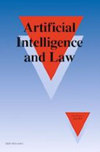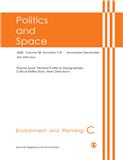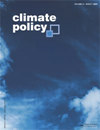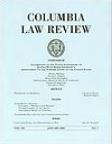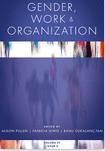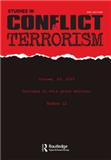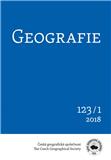Artificial Intelligence And Law
SCIESSCI国际简称:ARTIF INTELL LAW 参考译名:人工智能与法律
- 基本信息:
- ISSN:0924-8463
- E-ISSN:1572-8382
- 是否OA:未开放
- 是否预警:否
- TOP期刊:是
- 出版信息:
- 出版地区:NETHERLANDS
- 出版商:SPRINGER
- 出版语言:English
- 出版周期:4 issues per year
- 研究方向:Multiple
- 评价信息:
- 影响因子:3.1
- CiteScore指数:9.5
- SJR指数:1.501
- SNIP指数:3.467
- 发文数据:
- Gold OA文章占比:40.82%
- 研究类文章占比:97.44%
- 年发文量:39
- 自引率:0.2682...
- 开源占比:0.4066
- 出版撤稿占比:0
- 出版国人文章占比:0
- OA被引用占比:0.3902...
英文简介Artificial Intelligence And Law期刊介绍
Artificial Intelligence and Law is an international forum for the dissemination of original interdisciplinary research in the following areas: Theoretical or empirical studies in artificial intelligence (AI), cognitive psychology, jurisprudence, linguistics, or philosophy which address the development of formal or computational models of legal knowledge, reasoning, and decision making. In-depth studies of innovative artificial intelligence systems that are being used in the legal domain. Studies which address the legal, ethical and social implications of the field of Artificial Intelligence and Law.
Topics of interest include, but are not limited to, the following: Computational models of legal reasoning and decision making; judgmental reasoning, adversarial reasoning, case-based reasoning, deontic reasoning, and normative reasoning. Formal representation of legal knowledge: deontic notions, normative
modalities, rights, factors, values, rules. Jurisprudential theories of legal reasoning. Specialized logics for law. Psychological and linguistic studies concerning legal reasoning. Legal expert systems; statutory systems, legal practice systems, predictive systems, and normative systems. AI and law support for legislative drafting, judicial decision-making, and
public administration. Intelligent processing of legal documents; conceptual retrieval of cases and statutes, automatic text understanding, intelligent document assembly systems, hypertext, and semantic markup of legal documents. Intelligent processing of legal information on the World Wide Web, legal ontologies, automated intelligent legal agents, electronic legal institutions, computational models of legal texts. Ramifications for AI and Law in e-Commerce, automatic contracting and negotiation, digital rights management, and automated dispute resolution. Ramifications for AI and Law in e-governance, e-government, e-Democracy, and knowledge-based systems supporting public services, public dialogue and mediation. Intelligent computer-assisted instructional systems in law or ethics. Evaluation and auditing techniques for legal AI systems. Systemic problems in the construction and delivery of legal AI systems. Impact of AI on the law and legal institutions. Ethical issues concerning legal AI systems. In addition to original research contributions, the Journal will include a Book Review section, a series of Technology Reports describing existing and emerging products, applications and technologies, and a Research Notes section of occasional essays posing interesting and timely research challenges for the field of Artificial Intelligence and Law. Financial support for the Journal of Artificial Intelligence and Law is provided by the University of Pittsburgh School of Law.
期刊简介Artificial Intelligence And Law期刊介绍
《Artificial Intelligence And Law》是一本社会学优秀杂志。致力于发表原创科学研究结果,并为社会学各个领域的原创研究提供一个展示平台,以促进社会学领域的的进步。该刊鼓励先进的、清晰的阐述,从广泛的视角提供当前感兴趣的研究主题的新见解,或审查多年来某个重要领域的所有重要发展。该期刊特色在于及时报道社会学领域的最新进展和新发现新突破等。该刊近一年未被列入预警期刊名单,目前已被权威数据库SCIE、SSCI收录,得到了广泛的认可。
该期刊投稿重要关注点:
Cite Score数据(2024年最新版)Artificial Intelligence And Law Cite Score数据
- CiteScore:9.5
- SJR:1.501
- SNIP:3.467
| 学科类别 | 分区 | 排名 | 百分位 |
| 大类:Social Sciences 小类:Law | Q1 | 16 / 1025 |
98% |
| 大类:Social Sciences 小类:Artificial Intelligence | Q1 | 70 / 350 |
80% |
CiteScore 是由Elsevier(爱思唯尔)推出的另一种评价期刊影响力的文献计量指标。反映出一家期刊近期发表论文的年篇均引用次数。CiteScore以Scopus数据库中收集的引文为基础,针对的是前四年发表的论文的引文。CiteScore的意义在于,它可以为学术界提供一种新的、更全面、更客观地评价期刊影响力的方法,而不仅仅是通过影响因子(IF)这一单一指标来评价。
中科院SCI分区Artificial Intelligence And Law 中科院分区
| 大类学科 | 分区 | 小类学科 | 分区 |
| 社会学 | 2区 | LAW 法学 COMPUTER SCIENCE, ARTIFICIAL INTELLIGENCE 计算机:人工智能 COMPUTER SCIENCE, INTERDISCIPLINARY APPLICATIONS 计算机:跨学科应用 | 1区 2区 2区 |
中科院分区表 是以客观数据为基础,运用科学计量学方法对国际、国内学术期刊依据影响力进行等级划分的期刊评价标准。它为我国科研、教育机构的管理人员、科研工作者提供了一份评价国际学术期刊影响力的参考数据,得到了全国各地高校、科研机构的广泛认可。
中科院分区表 将所有期刊按照一定指标划分为1区、2区、3区、4区四个层次,类似于“优、良、及格”等。最开始,这个分区只是为了方便图书管理及图书情报领域的研究和期刊评估。之后中科院分区逐步发展成为了一种评价学术期刊质量的重要工具。
JCR分区Artificial Intelligence And Law JCR分区
| 按JIF指标学科分区 | 收录子集 | 分区 | 排名 | 百分位 |
| 学科:COMPUTER SCIENCE, ARTIFICIAL INTELLIGENCE | SCIE | Q2 | 86 / 197 |
56.6% |
| 学科:COMPUTER SCIENCE, INTERDISCIPLINARY APPLICATIONS | SCIE | Q2 | 65 / 169 |
61.8% |
| 学科:LAW | SSCI | Q1 | 8 / 421 |
98.2% |
| 按JCI指标学科分区 | 收录子集 | 分区 | 排名 | 百分位 |
| 学科:COMPUTER SCIENCE, ARTIFICIAL INTELLIGENCE | SCIE | Q1 | 24 / 198 |
88.13% |
| 学科:COMPUTER SCIENCE, INTERDISCIPLINARY APPLICATIONS | SCIE | Q1 | 20 / 169 |
88.46% |
| 学科:LAW | SSCI | Q1 | 48 / 421 |
88.72% |
JCR分区的优势在于它可以帮助读者对学术文献质量进行评估。不同学科的文章引用量可能存在较大的差异,此时单独依靠影响因子(IF)评价期刊的质量可能是存在一定问题的。因此,JCR将期刊按照学科门类和影响因子分为不同的分区,这样读者可以根据自己的研究领域和需求选择合适的期刊。
发文数据
- 国家/地区数量
- USA20
- Italy14
- Netherlands8
- England7
- France6
- Australia5
- Luxembourg5
- Belgium4
- Japan4
- Poland4
本刊中国学者近年发表论文
-
1、How to justify a backing's eligibility for a warrant: the justification of a legal interpretation in a hard case
Author: Yu, Shiyang; Chen, Xi
Journal: ARTIFICIAL INTELLIGENCE AND LAW. 2023; Vol. 31, Issue 2, pp. 239-268. DOI: 10.1007/s10506-022-09311-0
-
2、Policing based on automatic facial recognition
Author: Guo, Zhilong; Kennedy, Lewis
Journal: ARTIFICIAL INTELLIGENCE AND LAW. 2023; Vol. 31, Issue 2, pp. 397-443. DOI: 10.1007/s10506-022-09330-x
-
3、Methods of incorporating common element characteristics for law article prediction
Author: Hou, Yifan; Cheng, Ge; Zhang, Yun; Zhang, Dongliang
Journal: ARTIFICIAL INTELLIGENCE AND LAW. 2023; Vol. , Issue , pp. -. DOI: 10.1007/s10506-023-09359-6
-
4、A novel MRC framework for evidence extracts in judgment documents
Author: Zhou, Yulin; Liu, Lijuan; Chen, Yanping; Huang, Ruizhang; Qin, Yongbin; Lin, Chuan
Journal: ARTIFICIAL INTELLIGENCE AND LAW. 2023; Vol. , Issue , pp. -. DOI: 10.1007/s10506-023-09344-z
-
5、Detecting the influence of the Chinese guiding cases: a text reuse approach
Author: Chen, Benjamin M.; Li, Zhiyu; Cai, David; Ash, Elliott
Journal: ARTIFICIAL INTELLIGENCE AND LAW. 2023; Vol. , Issue , pp. -. DOI: 10.1007/s10506-023-09358-7
-
6、Semantic matching based legal information retrieval system for COVID-19 pandemic
Author: Zhu, Junlin; Wu, Jiaye; Luo, Xudong; Liu, Jie
Journal: ARTIFICIAL INTELLIGENCE AND LAW. 2023; Vol. , Issue , pp. -. DOI: 10.1007/s10506-023-09354-x
投稿常见问题
-
请问这本期刊属于什么级别呢?可用于职称评定吗?
一般刊物只分省级、部级、核心,期刊本身是没有几类划分的,具体是几类或者几级,您可以对照单位的分类文件确认一下。Artificial Intelligence And Law杂志是由SPRINGER出版的一本SCIE、SSCI,可用于职称评定。
-
你们能够提供哪些核心期刊的咨询服务?
大多数核心期刊我们都是可以提供咨询服务的。目前核心期刊主要分为以下几类:1.国内核心:按照权威度排序,社科类:南大核心>南大扩展>北大核心>科技核心 按照权威度排序。工科类:CSCD C库>CSCD E库(相当于CSCD扩展)>北大核心>科技核心。2.国外核心(全英文):按照权威度排序为:SSCI=SCI>EI>ISTP=CPCI。
-
想快速发表,可以加急吗?
为了确保您的职称评定顺利进行,我们建议提前半年到一年开始准备,这样能够保证有充足的时间来处理所有相关事宜。如果客户需要加急服务,我们会与杂志社进行沟通,以确定是否可以提供加急服务。请注意,如果确认可以加急,可能会收取一定的加急费用。
-
你们提供的服务可以确保稿件被发表吗?
期刊编辑会综合考虑多个因素,如发表范围、学术价值和原创性等,对稿件进行综合评估。尽管任何机构均无法保证每篇稿件都会被发表,但我们可以用专业知识和丰富经验,协助您理解并遵循期刊的发表要求,从而提高您的稿件被发表的机率。
-
请问期刊发表的费用如何?
期刊发表的费用因期刊不同而异。根据您的需求,我们会为您推荐性价比最高的期刊,并提供专业的期刊供您选择。一般来说,只要符合职称要求,大多数作者都会选择性价比最高的期刊作为意向期刊进行重点咨询。我们会为您提供详细的期刊信息和费用说明,以确保您能够做出明智的选择。
-
如果稿件被拒,未能成功发表,费用是否可以退还?
一般来说,我们推荐的期刊和您的专业方向、文章情况都是匹配的,极少出现稿件被拒的情况。如果稿件被拒,期刊编辑会提供详细的拒稿信和建议,以帮助您了解拒稿原因并改进您的稿件。关于退款政策,具体情况可能因期刊不同而异,请您咨询我们的工作人员以获取详细信息。
相关期刊推荐
热门期刊推荐
-
Humanities And Social Sciences Communications
中科院 2区 JCR
-
Electoral Studies
中科院 2区 JCR Q1
-
Journal Of Human Development And Capabilities
中科院 3区 JCR Q3
-
Land Use Policy
中科院 1区 JCR Q1
-
Technology In Society
中科院 1区 JCR Q1
-
Child & Family Social Work
中科院 3区 JCR Q2
-
Social Indicators Research
中科院 2区 JCR Q1
-
Asian Perspective
中科院 3区 JCR Q2
